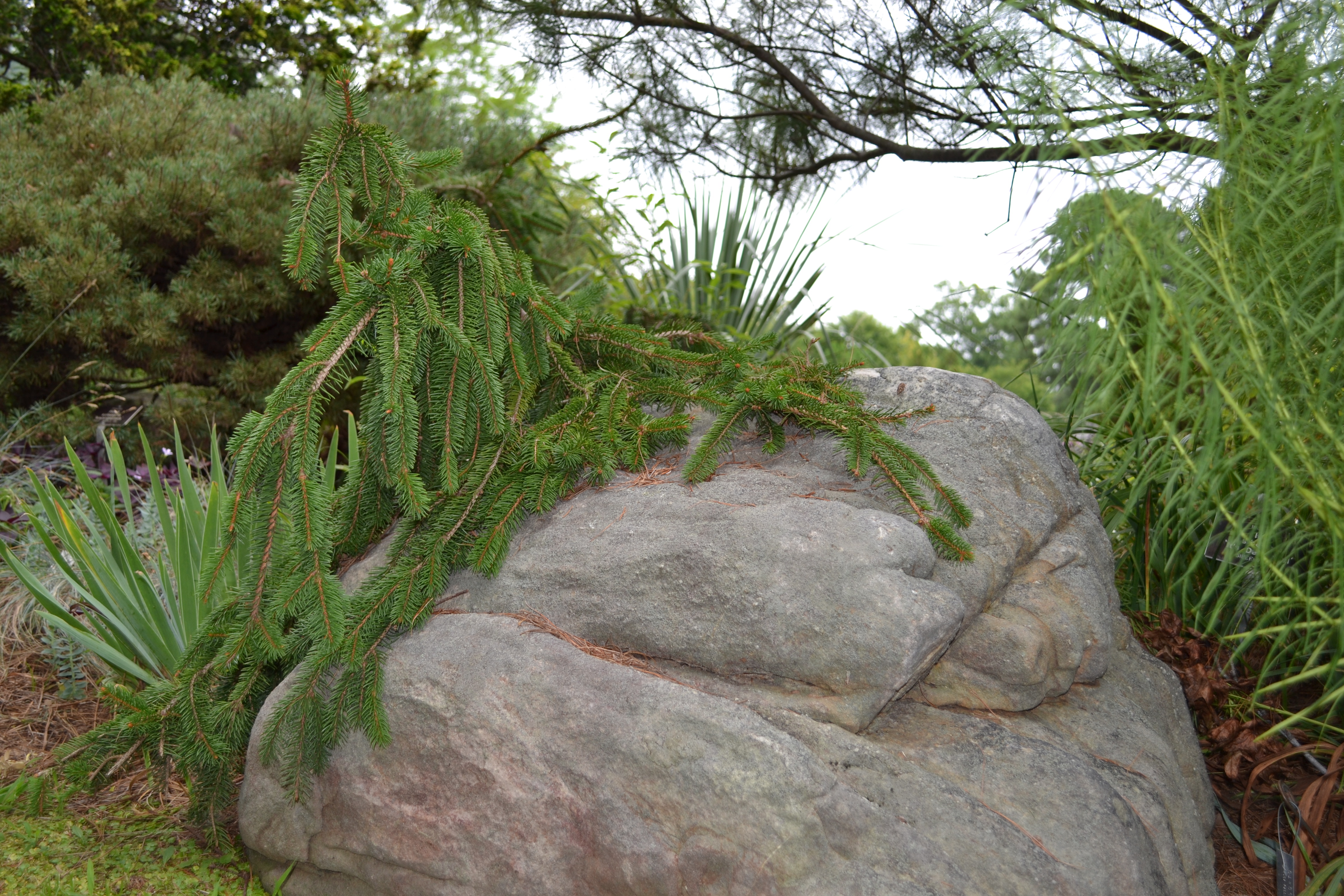The Margaret Johanna Streb Conifer Garden is a Hidden Gem off the Beaten Path
by Elizabeth Fogel, Senior Horticulturist & Seth Roadman, Horticulturist, Lewis Ginter Botanical Garden
Lewis Ginter Botanical Garden first opened to the public in 1987, fulfilling the will of Grace E. Arents to establish a botanical garden named after her uncle, Lewis Ginter. At this time, little of the Garden’s 81 acres were under cultivation, but it has changed and grown rapidly ever since. There are now over 35 acres under intense cultivation with more than a dozen themed gardens. The property includes a visitors center, two restaurants, and a classical domed Conservatory featuring changing displays and orchids. The education building houses a large library and several classrooms for the wide array of classes, workshops, and symposia offered. A 2-acre Children’s Garden offers endless hands-on activities for children and families. Whether you have 30 minutes or all day to explore there are many treasures, including countless beautiful conifers to be found.
The Margaret Johanna Streb Conifer Garden is a hidden gem off of the beaten path. Hugging the far end of our lake, it offers beautiful views of much of the garden. Built in 1995-96, this garden serves as our official conifer collection. A wide array of dwarf and slow growing conifers are inter-planted with perennials, minor spring bulbs and flowering shrubs. There are over 14 genera, 38 species and countless cultivars represented in this corner of the garden alone. But if you are coming to see conifers, you’ll want to explore the entire property. Beautiful conifer specimens from more than 27 genera can be found throughout the garden. The conifer collection throughout presents guests of the Garden with a broad array of specimens that exhibit outstanding attributes including attractive foliage, bark, interesting bud formation and unusual form and structure.
Foliage in our collection consists of many and varying shades of blue, green and yellow/golden varieties. Some of the conifers change hue in winter months. Other types display variegated leaf tips combining to make a wonderful range of color and interest such as Juniperus rigida ‘Hikari’. Both Thujopsis dolobrata and Fokienia hodginsii show glossy green foliage while the underside displays a silvery white color that is very attractive. Popular shades of blue in the garden include Cedrus deodara ‘Feelin’ Blue’, Pinus parviflora ‘Glauca’, Cupressus arizonica ‘Blue Ice’, Picea pungens ‘Royal Knight’, Pinus sylvestris ‘Beuvronensis’ and Pinus flexilis ‘Vanderwolf’s Pyramid’. Other conifers provide striking golden yellow color especially in the winter. Pinus strobus ‘Hillside Winter Gold’, Chamaecyparis obtusa ‘Lemon Twist’, Cryptomeria japonica ‘Sekkan-Sugi’, Thuja occidentalis ‘Pumila Sudworth’ are fine examples intermingled between other evergreen and deciduous trees in the garden. Brilliant yellow coloration of Ginkgo biloba in the Grace Arents Garden provides spectacular autumn interest. Thuja occidentalis ‘Rheingold’ develops a copper bronze color in winter and Cryptomeria japonica ‘Elegans Nana’ a deep purple hue that begins when the days become shorter and nights cooler.
A transformation of conifers in our collection begins when new growth emerges in spring and is most noticeable on Pinus and Picea species. New shoot growth, often referred to as “candles,” emerge covered in white colored hairs frequently of a different color from the leaves of the prior season. Pinus thunbergii ‘Thunderhead’ renders a white against green contrast when the growth begins. Other specimens in the collection that provide these attractive candles are Pinus densiflora ‘Oculus-draconis’ and Picea orientalis ‘Compacta’.
Another important attribute of the conifers in our collection include their shape or form. Several Cedrus atlantica ‘Glauca Pendula’ are trained prostrate in the garden. Globose or ball-shaped is most recognized and popular among dwarf conifers. Cryptomeria japonica ‘Globosa Nana’and Pinus mugo are excellent examples of this form. Fastigiate or columnar forms add to vertical interest and Juniperis scopulorum ‘Skyrocket’ found at the entrance of the Streb garden is an example of an upright form with erect branches. Pendulous forms such as Chamaecyparis nootkatensis ‘Green Arrow’ in the Streb garden and Picea abies ‘Pendula’ in the Flagler Perennial Garden present an eye-catching focal point.
Certain conifers in the garden have unusual forms which may best be described as intriguing. ‘Cristata’, a cultivar of Cryptomeria japonica, has congested foliage resembling that of coral reef while Cryptomeria japonica ‘Araucarioides’ found at the entrance of the Streb Garden has twisted stems and leaves adding to its uniqueness. Picea abies ‘Ziegler’s Weeping’ is an interesting weeper in which branches literally lay across the ground. Pinus contorta ‘Spaan’s Dwarf’ and Pinus parviflora ‘Adcock’s Dwarf’ are unequaled dwarf varieties and have a place in rock gardens or small spaces. Taxodium distichum around Sydnor lake produce buttressed trunks and interesting knee-like formations that provide these trees with anchor support in wet conditions.
The more mature conifers often develop impressive and attractive bark. Pinus densiflora ‘Umbraculifera’ in the Asian garden exhibits exfoliating bark that is reddish brown in color. This tree is grown as a standard to reveal the handsome bark. Pinus bungeana behind the Flagler pavilion exhibits bark that exfoliates in patches of green, grey, white and brown.
This is just a small sample of the treasures to be found at Lewis Ginter Botanical Garden, and whatever your preference, you are sure to find something to delight you. You must visit in every season to fully appreciate all that the Garden has to offer conifer lovers. Proud to be an American Conifer Society member garden, we continue to add to our collection as we can.
Edited from text originally published in the August 2012 issue of Southeastern Conifer.
